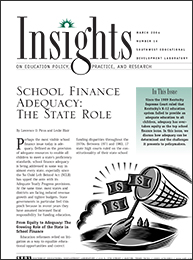What Does All this Mean for Policymakers?
What is clear from the policy debates surrounding adequacy in states today is that reaching agreement about what constitutes an adequate education and finding the funds to pay for it is rife with complexities. Finding the political consensus to develop and fund an adequate system has been difficult. School districts often resist new ÔmandatesÕ from the state and call for full funding of new requirements. Legislators faced with the typically large price tag of adequacy reforms often balk at passing new taxes to fund the system, and many in districts where students are generally succeeding argue that schools need to be more efficient and do a better job with what they have, rather than ask for more. Finding a consensus, even when an adequacy study has been completed, is very difficult.
At the same time, to estimate adequate funding levels, it is necessary to develop prototype schools that have a mix of resources that are needed to provide an adequate education. Legislators and policymakers are then faced with the dilemma of mandating the structure used to estimate costs, or to allow districts to receive the funds through a block grant or general form of aid. Policymakers routinely ask what they should do if districts accept the new higher levels of funding, but then choose to allocate resources in very different patterns and then fail to meet state performance standards.
One certainty has emerged from all of the recent school finance adequacy work: the process is not easy. Moreover, adequacy models tend to become complex very quickly because of efforts to meet a wide range of special needs that are typically found when the adequacy measure is implemented in a school finance system. For that reason, policymakers should insist that adequacy models be straightforward and easy to understand. Although not easy to do, making sure the funding model is understandable to and supported by both policymakers and the public is essential if the new (and so far always higher) funding levels are to be put in place.
Next Page: How Do Policymakers Select a Model?

